Software > OpenVMS Systems > Documentation > 82final > 6552 HP OpenVMS Systems Documentation |
HP Availability Manager User's Guide
6.4.3.3 LAN VC Checksumming FixThis page (Figure 6-24) allows you to turn checksumming on or off for the virtual circuit.
Figure 6-24 LAN VC Checksumming Page 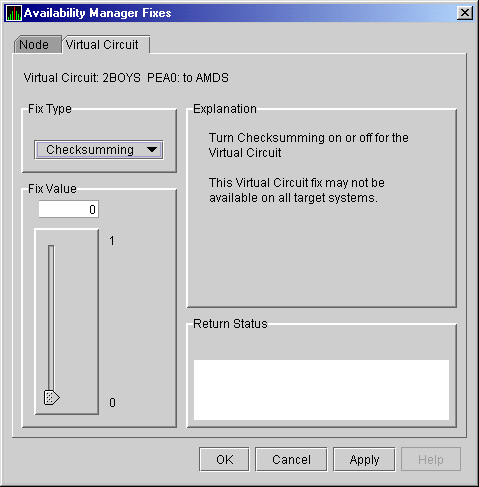
6.4.3.4 LAN VC Compression FixThis page (Figure 6-24) allows you to turn compression on or off for the virtual circuit.
Figure 6-25 LAN VC Compression Page 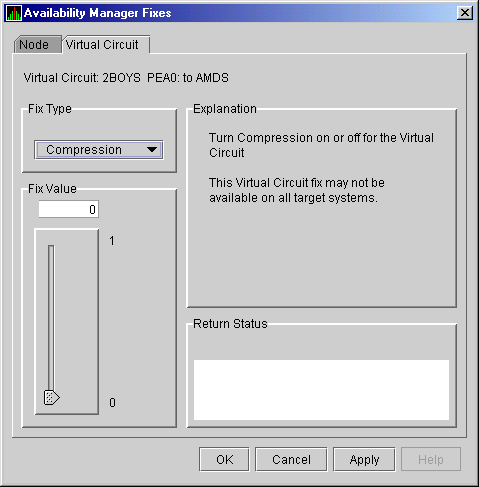
6.4.4 LAN Channel FixesTo access LAN path fixes, right-click an item in the LAN Channel Summary category (see Figure 4-7). The Availability Manager displays a popup menu with the following options:
Click the Fixes... menu item to display this list of available fixes:
These fixes are described in the following sections. 6.4.4.1 LAN Path Adjust Priority FixThis page (Figure 6-26) allows you to change the cost associated with this channel. This, in turn, affects the routing of cluster traffic. Figure 6-26 LAN Path Adjust Priority Page 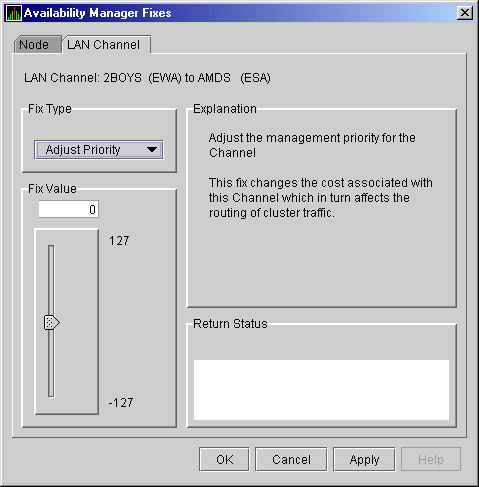
6.4.4.2 LAN Path Hops FixThis page (Figure 6-27) allows you to change the hops for the channel. This fix changes the hops value associated with this channel. This, in turn, affects the routing of cluster traffic.Figure 6-27 LAN Path Hops Page 
6.4.4.3 LAN Path Maximum Packet Size FixThis page (Figure 6-28) allows you to set the maximum packet size associated with this channel. This, in turn, affects the routing of cluster traffic.
Figure 6-28 LAN Path Maximum Packet Size Page 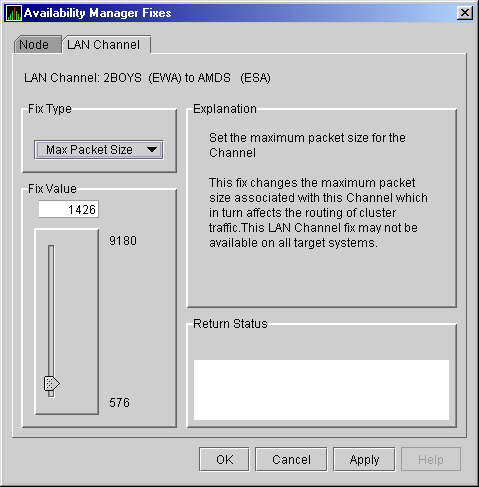
6.4.5 LAN Device FixesTo access LAN device fixes, right-click an item in the LAN Path (Channel) Summary category (see Figure 4-7). The Availability Manager displays a popup menu with the following options:
Select the LAN Device Details menu item to display the LAN Device Details window. From the Devicer Details window, select Fix... from the Fix menu. The Availability Manager displays the first of several pages, each of which contains a fix option: Adjust Priority These fixes are described in the following sections. 6.4.5.1 LAN Device Adjust Priority FixThis page (Figure 6-29) allows you to adjust the management priority for the device. This fix changes the cost associated with this device. This, in turn, affects the routing of cluster traffic. Figure 6-29 LAN Device Adjust Priority Page 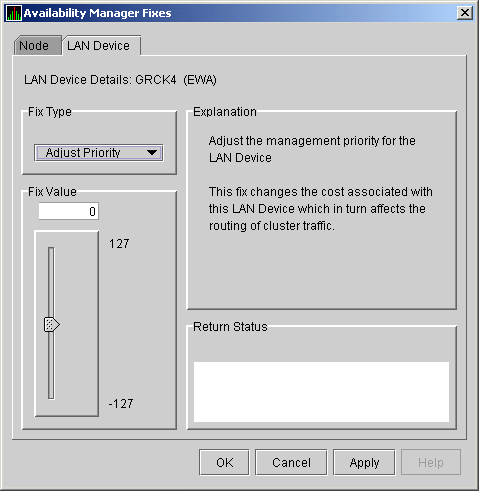
6.4.5.2 LAN Device Set Maximum Buffer FixThis page (Figure 6-30) allows you to set the maximum packet size for the device. This fix changes the maximum packet size associate with this channel. This, in turn, affects the routing of cluster traffic.Figure 6-30 LAN Device Set Maximum Buffer Size Page 
6.4.5.3 LAN Device Start FixThis page (Figure 6-31) starts the use of this device. This fix enables the use of this device for cluster traffic.Figure 6-31 LAN Device Start Page 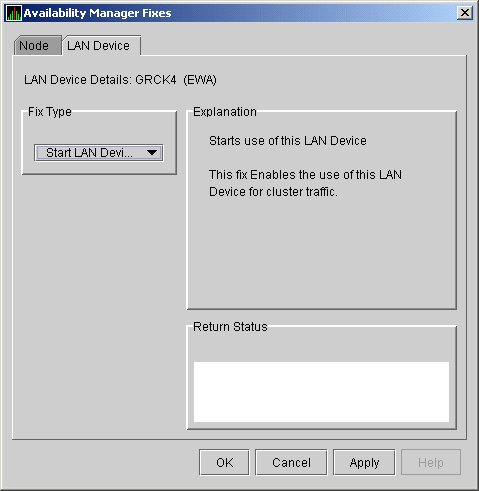
6.4.5.4 LAN Device Stop FixThis page (Figure 6-32) stops the use of this device . This fix disables the use of this device for cluster traffic.
Figure 6-32 LAN Device Stop Page 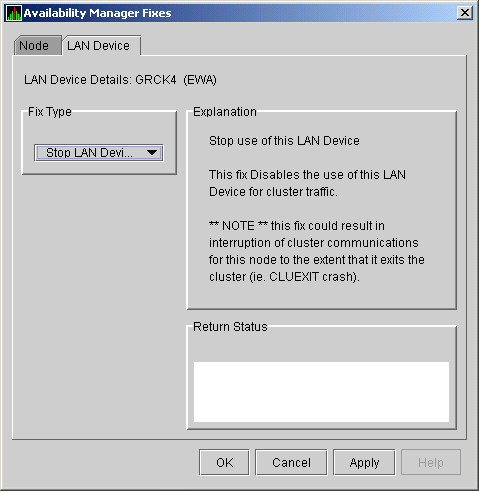
Chapter 7
|
| Feature | Description |
|---|---|
| Nodes or node groups | You can select one or more groups or individual nodes to monitor. |
| Data collection | For OpenVMS nodes, you can choose the types of data you want to collect as well as set several types of collection intervals. (On Windows nodes, specific types of data are collected by default.) |
| Data filters | For OpenVMS nodes, you can specify a number of parameters and values that limit the amount of data that is collected. |
| Event filters | You can specify the severity of events that are displayed as well as several other filter settings for events. |
| Security | On Data Analyzer and Data Collector nodes, you can change passwords. On OpenVMS Data Collector nodes, you can edit a file that contains security triplets. |
| Watch process | You can specify up to eight processes for the Availability Manager to monitor and report on if they disappear and also if they subsequently reappear. |
In addition, you can change the group membership of nodes as explained in Section 7.3.
Table 7-1 shows the levels of customization the Availability Manager provides. At each level, you can customize specific features. The table shows which features can be customized at which levels.
| Customizable Features | A.M. Default | Application | Operating System | Group | Node |
|---|---|---|---|---|---|
| Nodes or node groups | X | X | |||
| Data collection | X | X | X | X | |
| Data filters | X | X | X | X | |
| Event filters | X | X | X | X | |
| Security | X | X | X | X | |
| Watch process | X | X | X | X |
You can customize each feature at one or more of the following levels, as shown in Table 7-1:
The Availability Manager (A.M.) Default level consists of values that are preset within the Availability Manager. Any customization overrides A.M. Default values. For example, customizing values for filters at the Group level overrides values for filters at the Operating System level. Similarly, customizing values for filters at the Node level overrides values for filters at the Group level. The Application level is unique because it is the only level at which you can select or change the nodes or groups of nodes you want to display.
To return to the values set at the preceding level, you can click the Use default values button at the top of the customization page.
Examples of Setting Levels of Customization
If you monitor several groups but the password for the nodes in one of those groups is different from the password of nodes in other groups, right-click the group you want to change, choose Customize from the popup menu, click the Security tab, and change the password. This new password is then used for each node that is a member of that group.
As a second example, to change the password of one node in a group to a different password than the other nodes in the group, right-click that node, choose Customize, click the Security tab, and change the password to one that differs from the other nodes in the group. For that node, the new password overrides the group password.
The Availability Manager keeps track of the next higher level of a particular setting. This means that you can reset a value to that of the next higher level. In the second password example, if you want to set the password for the single node back to the password that the rest of the group uses, simply click the Use default value button. The password value for the node now comes from the group-level password setting. At this point, if you change the group password, all the nodes in the group have the new password.
Understanding the Terms "Use Default Value" and "System Default"
The Use default value button and the "system default" setting are not necessarily the same value. A system default is a value stored in the Availability Manager and is a value that is used until a user overrides it. Clicking the Use default value button sets a value to conform to the value set at the next higher level of customization.
If you want to override the system default for all OpenVMS nodes, click the Customize button on the main menu bar, and choose Customize OpenVMS. Whatever changes you make subsequently are set for all OpenVMS nodes except those nodes on which a particular parameter has been set at the group or node level.
A two-line status box at the bottom of the Customization page tells you the level at which the selected parameter will be configured and what level the value will come from if you press the Use default value button. In this way, you can tell what level of customization you are overriding when you make changes.
In the main Application window (see Figure 1-1), you can select the levels of customization that are shown in Table 7-1. The following sections explain these levels.
In the Application window menu bar, click the Customize menu. The Availability Manager displays the popup menu shown in Figure 7-1.
Figure 7-1 Application and Operating System Customization Menu

Notice that you have a choice of two levels of customization: application and operating system levels. The operation system level has two choices: Windows NT and OpenVMS. The following sections describe these choices.
When you choose Customize Application, the Availability Manager displays the page shown in Figure 7-2, where you can select groups of nodes or individual nodes to be displayed. Section 7.2 explains how to do this.
Figure 7-2 Application Customization Page
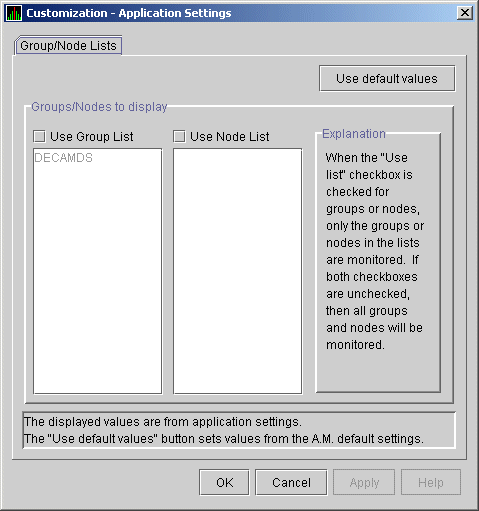
When you choose Customize Windows NT, the Availability Manager displays the page shown in Figure 7-3.
Figure 7-3 Windows Operating System Customization Page
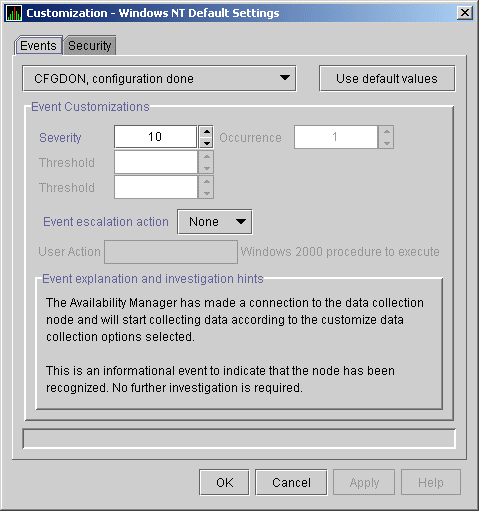
The default page displayed is the Events Customization page. Instructions for using this page are in Section 7.6.1. The other tab displayed is the Security Customization page, which is explained in Section 7.7.1.2.
When you choose Customize OpenVMS, the Availability Manager displays the page shown in Figure 7-4, which contains tabs for the last five types of customizations listed in Table 7-1.
Figure 7-4 OpenVMS Operating System Customization Page

To perform customizations at the group level, right-click a group name in the Application window. The Availability Manager displays a small menu similar to the one shown in Figure 7-5.
Figure 7-5 Group Customization Menu

When you choose Customize, the Availability Manager displays the page shown in Figure 7-4.
To customize a specific node, right-click a node name in the Node pane of the Application window (see Figure 1-1). The Availability Manager displays the popup menu shown in Figure 7-6.
You can customize nodes in any state, not just those displayed in red or green (colors that indicate that the security check has been successful for these nodes). |
Figure 7-6 Node Customization Menu
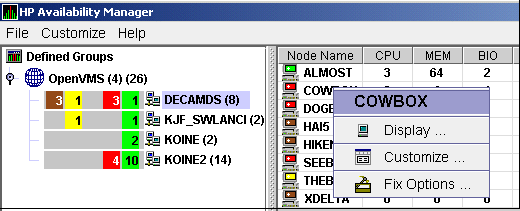
When you choose Customize, the Availability Manager displays a customization page similar to the one shown in Figure 7-4.
Number of Nodes Affected by Customization
Depending on which customization menu you use and your choice of menu items, your customizations can affect one or more nodes, as indicated in the following table.
| Nodes Affected | Action |
|---|---|
| All nodes | Choose Customize Application... on the menu shown in Figure 7-1. |
| All Windows nodes | Choose Customize Windows NT... on the menu shown in Figure 7-1. |
| All OpenVMS nodes | Choose Customize OpenVMS... on the menu shown in Figure 7-1. |
| A group of nodes | Choose Customize... on the popup menu shown in Figure 7-5. The customization options you choose affect only the group of nodes that you select. |
| One node | Choose Customize... on the popup menu shown in Figure 7-6. The customization options you choose affect only the node that you select. |
When you choose Customize Application on the Application window Customize menu (Figure 7-1), the Availability Manager displays a Group/Node Lists tab (Figure 7-7).
Figure 7-7 Group/Node Customization Page

You have the following choices:
If you decide to return to the default (Use Group List: DECAMDS) or to enter names again, click Use default values.
After you enter a list of nodes or groups of nodes, click one of the following buttons at the bottom of the page:
| Option | Description |
|---|---|
| OK | Accepts the choice of names you have entered and exits the page. |
| Cancel | Cancels the choice of names and does not exit the page. |
| Apply | Accepts the choice of names you have entered but does not exit the page. |
To put the list into effect, exit the Availability Manager and restart it.
Each Availability Manager Data Collector node is assigned to the DECAMDS group by default. The following sections explain how to change the group membership of nodes.
You need to place nodes belonging to the same cluster in the same group. If such nodes are placed in different groups, some of the data collected might be misleading. |
You need to edit a logical on each Data Collector node to change the group for that node. To do this, follow these steps:
$ AMDS$DEF AMDS$GROUP_NAME FINANCE ! Group FINANCE; OpenVMS Cluster alias |
$ @SYS$STARTUP:AMDS$AM_STARTUP RESTART |
The configuration files for DECamds and the Availability Manager are separate; only one set is used, depending on which startup command procedure you use to start the driver. For further explanations of the configuration files set up for both DECamds and the Availability Manager, refer to the HP Availability Manager Installation Instructions for OpenVMS Alpha Systems |
You need to edit the Registry to change the group of a Windows node. To edit the Registry, follow these steps:
| Previous | Next | Contents | Index |